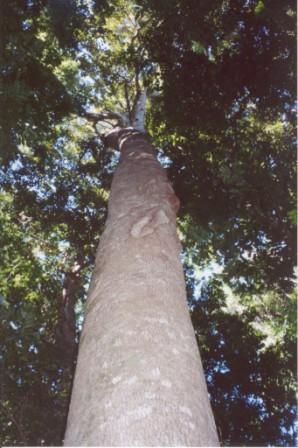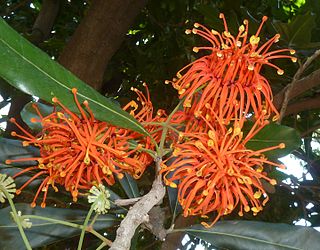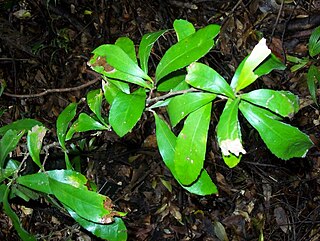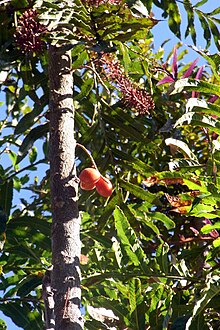
Floydia is a monotypic genus of plants in the macadamia family Proteaceae which is endemic to Australia. The sole described species is Floydia praealta, commonly known as the ball nut. It is a somewhat rare tree found only growing in the rainforests of southeastern Queensland and northeastern New South Wales. The tree has a superficial resemblance to the closely related Macadamia and could be confused with them. The fruit of F. praealta is poisonous.

Hicksbeachia is a genus of two species of trees in the family Proteaceae. They are native to rainforests of northern New South Wales and southeastern Queensland. They are commonly known as red bopple nut or beef nut due to the bright red colour of their fruits.

Banksia petiolaris is a rare species of flowering plant in the family Proteaceae native to Western Australia, where it is found in sandy soils in the south coastal regions from Munglinup east to Israelite Bay. It was first described by Victorian state botanist Ferdinand von Mueller in 1864, and no subspecies are recognised. B. petiolaris is one of several closely related species that will all grow as prostrate shrubs, with horizontal stems and thick, leathery upright leaves. Those of this species can be viable for up to 13 years—the longest-lived of any flowering plant recorded. It bears yellow cylindrical flower spikes, known as inflorescences, up to 16 cm high in spring. As the spikes age, they turn grey and develop up to 20 woody seed pods, known as follicles, each.

The Proteaceae form a family of flowering plants predominantly distributed in the Southern Hemisphere. The family comprises 83 genera with about 1,660 known species. Australia and South Africa have the greatest concentrations of diversity. Together with the Platanaceae, Nelumbonaceae and in the recent APG IV system the Sabiaceae, they make up the order Proteales. Well-known 'Proteaceae genera include Protea, Banksia, Embothrium, Grevillea, Hakea and Macadamia. Species such as the New South Wales waratah, king protea, and various species of Banksia, Grevillea, and Leucadendron are popular cut flowers. The nuts of Macadamia integrifolia are widely grown commercially and consumed, as are those of Gevuina avellana on a smaller scale.
Triunia is a genus of medium to tall shrubs or small trees found as understorey plants in rainforests of eastern Australia. Members of the plant family Proteaceae, they are notable for their poisonous fleshy fruits or drupes. Only one species, T. youngiana, is commonly seen in cultivation.

Gmelina leichhardtii, the white beech, is a tree of eastern Australia. Scattered individuals or small groups of trees naturally occur from the Illawarra district of New South Wales to near Proserpine in tropical Queensland. The white beech or grey teak is a fast-growing tree, growing on volcanic and alluvial soils in areas of moderate to high rainfall. It also grows on poorer sedimentary soils in fire free areas. White beech may occasionally be seen in Australian rainforests, though their status is considered "uncommon". Unlike the Australian red cedar, the white beech has not recovered particularly well after logging in the 19th and 20th centuries.

Stenocarpus sinuatus, known as the firewheel tree, is an Australian rainforest tree in the family Proteaceae. The range of natural distribution is in various rainforest types from the Nambucca River in New South Wales to the Atherton Tableland in tropical Queensland. Stenocarpus sinuatus is widely planted as an ornamental tree in other parts of Australia and in different parts of the world.

Syzygium floribundum, synonym Waterhousea floribunda, is a rainforest tree of eastern Australia. It grows along streams from the Williams River near Dungog to Mackay in central eastern Queensland. Known as the weeping lilli pilli, this tree is widely planted as an ornamental. Planted trees from 1827 may be seen at the Royal Botanic Gardens, Sydney. However, these trees are damaged and threatened by the roosting grey headed flying foxes. A very large tree is located at Western Park in Auckland, New Zealand.

Elaeocarpus bancroftii, commonly known as Kuranda quandong, Johnstone River almond, ebony heart, grey nut, or nut tree is a large rainforest tree in the family Elaeocarpaceae which is endemic to Queensland. It has coriaceous leaves, attractive white flowers and relatively large fruit containing an edible kernel.

Clerodendrum tomentosum, known as the downy chance, hairy lolly bush, hairy clairy or hairy clerodendrum is a shrub or small tree occurring in eastern and northern Australia. Distributed from Batemans Bay in southern coastal New South Wales, Queensland, Northern Territory, Western Australia, and New Guinea.

Helicia glabriflora is a species of rainforest shrubs or small trees occurring in eastern Australia. Common names include smooth or pale helicia, pale, leather or brown oak. They grow naturally in a variety of different rainforest types from the Illawarra, New South Wales to the Townsville area, Queensland. Of all the global diversity of approximately one hundred Helicia species, this one species naturally grows the furthest south, in the Minnamurra Rainforest and the Robertson area, Illawarra, New South Wales, there observed more on the relatively fertile basalt and alluvial soils.

Cryptocarya bidwillii, the yellow laurel, is a small to medium-sized tree in the laurel family. Occurring in Australian rainforests from Nymboida in the state of New South Wales to Townsville in tropical Queensland. Often found in the dryer ridges in dry rainforest or in viney scrubs.

Aristolochia praevenosa, synonym Pararistolochia praevenosa, is an Australian plant in the birthwort family, native to Queensland and New South Wales. The Richmond birdwing butterfly vine grows in subtropical rainforest in coastal areas north from Wollongbar, in far north eastern New South Wales and adjacent areas in south eastern Queensland. It has been recorded as far north as the Mary River. It also grows in tropical north eastern Queensland, where it is a food plant for the Cairns birdwing butterfly.

Persoonia lanceolata, commonly known as lance-leaf geebung, is a shrub native to New South Wales in eastern Australia. It reaches 3 m (10 ft) in height and has smooth grey bark and bright green foliage. Its small yellow flowers grow on racemes and appear in the austral summer and autumn, followed by green fleshy fruits which ripen the following spring. Within the genus Persoonia, P. lanceolata belongs to the lanceolata group of 58 closely related species. It interbreeds with several other species found in its range.

Grevillea stenobotrya is a shrub or small tree in the family Proteaceae that is endemic to arid regions of Australia. Common names include rattle-pod grevillea, sandhill grevillea, sandhill oak and sandhill spider flower.

Buckinghamia celsissima, commonly known as the ivory curl tree, ivory curl flower or spotted silky oak, is a species of tree in the family Proteaceae. It is endemic to the tropical rainforests of northeastern Queensland, Australia.

Carnarvonia araliifolia, commonly known as the red oak, red silky oak, Caledonian oak or elephant's foot, is the sole species in the monotypic genus Carnarvonia, a member of the Proteaceae plant family. It is endemic to the rainforests of northeastern Queensland.

Harpullia hillii, commonly known as blunt-leaved tulip or oblong-leaved tulip, is a tree in the family Sapindaceae, endemic to eastern Australia. It occurs in dry rainforest from the Burdekin River in Queensland southwards to Wauchope, New South Wales.

Atkinsonia is a hemi-parasitic shrub with oppositely set, entire leaves and yellowish, later rusty-red colored flowers, that is found in Eastern Australia. It is a monotypic genus, the only species being Atkinsonia ligustrina, and is assigned to the showy mistletoe family, Loranthaceae. It is sometimes called Louisa's mistletoe.

Ackama paniculosa, synonym Caldcluvia paniculosa, known as the soft corkwood, is a rainforest tree of eastern Australia. It occurs from Ourimbah, Central Coast at 33° S to Eungella National Park in tropical Queensland. Other common names include corkwood, rose-leaf marara, brown alder and sugarbark.





















